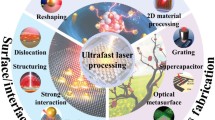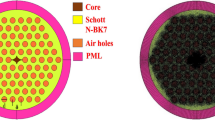Abstract
The re-deposition of the ejected \(\hbox {SiO}_{2}\) particles on the substrate during laser-induced damage of fused silica affects the light field modulation and the beam propagation quality. In this paper, the ejected \(\hbox {SiO}_{2}\) particles were firstly classified based on the experimental results. Then, the modulation resulting from three types of particles, square, round, and triangular was simulated. Meanwhile, the influences of the particle shape, size, position, and laser wavelength on the field modulation were studied. It showed that the field enhancement factor (FEF) has crucial correlations with the particle size, position, and laser wavelength. When the irradiated laser wavelength was 1064 nm, the square particles located on the front surface, the round particles located on the rear surface of the fused silica generated the largest FEF, respectively. The FEF resulted from the round particles was the largest regardless of whether the particles locate on the front or rear surface when the irradiated laser wavelength was 355 nm. The results also showed that no matter what type of particles, they will be easy to induce the surface or bulk damage of fused silica when they are located on the front surface. In contrast, the maximum field modulation appears in the air when the particles are located on the rear surface. It showed that the field modulation was not the main reason to induce rear surface damage of the fused silica.
Graphical abstract















Similar content being viewed by others
Data Availability Statement
This manuscript has no associated data or the data will not be deposited. [Author’s comment: All data included in this manuscript can be reproduced by performing simulations in accord with the approaches described here, or are available upon request by contacting the corresponding author.]
References
A.A. Manenkov, Fundamental mechanisms of laser-induced damage in optical materials: todays state of understanding and problems. Opt. Eng. 53, 010901 (2014)
Y. Jiang, S.B. He, W. Liao, C.Z. Yao, H.J. Wang, B.Y. Wang, S.H. Guan, R. Qiu, D.C. Guo, X. Xiang, C.M. Liu, X.D. Yuan, X.T. Zu, Theoretical and experimental investigations of localized CO2 laser-fused silica interactions and thermo-mechanical properties of mitigated sites. J. Non-Cryst. Solids 515, 1 (2019)
X. He, H. Zhao, G. Wang, P.F. Zhou, P. Ma, Correlation of polishing-induced shallow subsurface damages with laser-induced gray haze damages in fused silica optics. Chin. Phys. B 25, 088105 (2016)
X. He, C. Cai, G. Wang, H. Zhao, L. Xie, Y. Huang, D.Y. Yan, P. Ma, Effect of pad elastic modulus on polishinginduced subsurface damages distribution and laser-induced damage performance of fused silica optics. Opt. Exp. 27, 265 (2019)
S.G. Demos, R.A. Negres, R.N. Raman, A.M. Rubenchik, M.D. Feit, Material response during nanosecond laser induced breakdown inside of the exit surface of fused silica. Laser Photonics Rev. 7, 444 (2013)
C.W. Carr, H.B. Radousky, A.M. Rubenchik, M.D. Feit, S.G. Demos, Localized dynamics during laser induced damage in optical materials. Phys. Rev. Let. 92, 087401 (2004)
Y. Jiang, X. Xiang, C.M. Liu, C.S. Luo, H.J. Wang, X.D. Yuan, S.B. He, W. Ren, H.B. Lü, W.G. Zheng, X.T. Zu, Two localized CO2 laser treatment methods for mitigation of UV damage growth in fused silica. Chin. Phys. B 21, 064219 (2012)
Y. Jiang, C.M. Liu, C.S. Luo, X.D. Yuan, X. Xiang, H.J. Wang, S.B. He, H.B. Lü, W. Ren, W.G. Zheng, X.T. Zu, Mitigation of laser damage growth in fused silica by using a non-evaporative technique. Chin. Phys. B 21, 054216 (2012)
C.C. Zhang, L.J. Zhang, X.L. Jiang, B.S. Jia, W. Liao, R.C. Dai, J. Chen, X.D. Yuan, X.D. Jiang, Influence of pulse length on heat affected zones of evaporatively-mitigated damages of fused silica optics by CO2 laser. Opt. Laser Eng. 125, 105857 (2020)
T. Doualle, L. Gallais, S. Monneret, S. Bouillet, A. Bourgeade, C. Ameil, L. Lamaignère, P. Cormont, CO2 laser microprocessing for laser damage growth mitigation of fused silica optics. Opt. Eng. 56, 011022 (2017)
N. Shen, J.D. Bude, C.W. Carr, Model laser damage precursors for high quality optical materials. Opt. Exp. 22, 3393 (2014)
X.Y. Sun, Z.M. Lei, X.Q. Lu, D.Y. Fan, Mechanism of original damage of thin optical components induced by surface particle contamination. Acta Phys. Sin. 63, 134201 (2014)
N. Bloembergen, Role of cracks, pores, and absorbing inclusions on laser induced damage threshold at surfaces of transparent dielectrics. Appl. Opt. 12, 661 (1973)
F.Y. Genin, A. Salleo, T.V. Pistor, L.L. Chase, Role of light intensification by cracks in optical breakdown on surfaces. J. Opt. Soc. Am. A 18, 2607 (2001)
Y.F. Cai, Z.W. Lv, S.S. Li, Y.L. Wang, C.Y. Zhu, D.Y. Lin, W.M. He, Systematic studies on the field enhancement effect of Hertzian microcracks. Acta Phys. Sin. 62, 234203 (2013)
J.R. Hua, L. Li, X. Xiang, X.T. Zu, Three-dimensional numerical simulation of light field modulation in the vicinity of inclusions in silica subsurface. Acta Phys. Sin. 60, 044206 (2011)
G.D. Stavros, A.N. Raluca, Morphology of ejected particles and impact sites on intercepting substrates following exit-surface laser damage with nanosecond pulses in silica. Opt. Eng. 56, 011016 (2017)
S.G. Demos, R.A. Negres, R.N. Raman, N. Shen, M.R. Alexander, J.M. Manyalibo, Mechanisms governing the interaction of metallic particles with nanosecond laser pulses. Opt. Exp. 24, 7792 (2016)
B.C. Stuart, M.D. Feit, A.M. Rubenchik, B.W. Shore, M.D. Perry, Laser-induced damage in dielectrics with nanosecond to subpicosecond pulses. Phys. Rev. Lett. 74, 2248 (1995)
G.D. Stavros, A.N. Raluca, N.R. Rajesh, N. Shen, A.M. Rubenchik, J.M. Manyalibo, Mechanisms governing the interaction of metallic particles with nanosecond laser pulses. Opt. Exp. 24, 7792 (2016)
F.Y. GeNin, M.D. Feit, M.R. Kozlowski, A.M. Rubenchik, A. Salleo, J. Yoshiyama, Rear-surface laser damage on 355 nm silica optics owing to Fresnel diffraction on front-surface contamination particles. Appl. Opt. 39, 3654 (2000)
R.N. Raman, S.G. Demos, N. Shen, E. Feigenbaum, R.A. Negres, S. Elhadj, A.M. Rubenchik, M.J. Matthews, Damage on fused silica optics caused by laser ablation of surface-bound microparticles. Opt. Exp. 24, 2634 (2016)
Acknowledgements
This work was supported by the National Natural Science Foundation of China (11972313, 61505170, 61775235, 61705205) and the National Defense Basic Scientific Research program of China (Grant No. JCKY2020210C005).
Author information
Authors and Affiliations
Contributions
The authors contributed to this paper in the following proportions: YJ (theoretical calculations, discussion of results)—50%, BZ (experimental analysis)— 10%, HL (experimental analysis)— 10%, FZ (theoretical calculations)—10%, BW (theoretical calculations)—5%, WZ (the simulation analysis)—5%, DG (simulation analysis, discussion of results)—10%
Corresponding author
Rights and permissions
About this article
Cite this article
Jiang, Y., Zhang, B., Liu, H. et al. Light field modulation of ejected \(\hbox {SiO}_{2}\) particles on fused silica surface. Eur. Phys. J. D 75, 282 (2021). https://doi.org/10.1140/epjd/s10053-021-00293-3
Received:
Accepted:
Published:
DOI: https://doi.org/10.1140/epjd/s10053-021-00293-3




